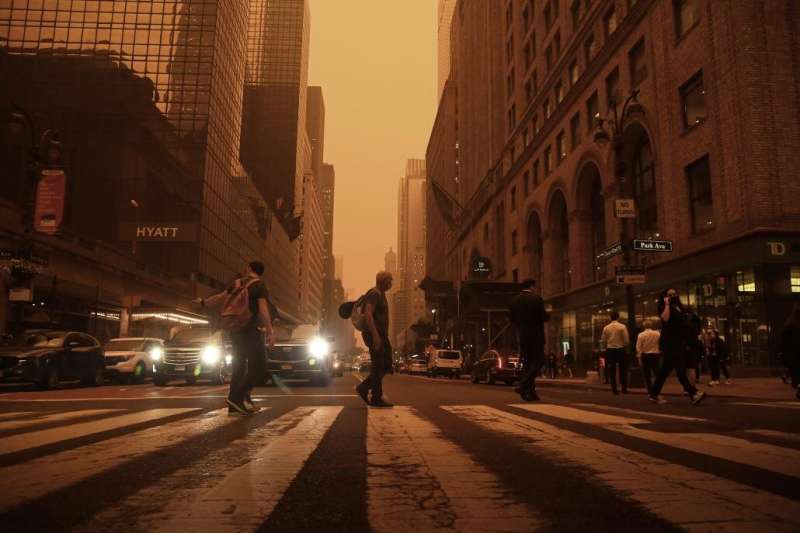This article has been reviewed according to Science X's editorial process and policies. Editors have highlighted the following attributes while ensuring the content's credibility:
fact-checked
trusted source
proofread
Wildfires likely to grow more common on East Coast, experts predict

Up and down the East Coast, air quality plummeted, schools closed, and Major League Baseball games got postponed—all a result of the smog blown downstream from the 400-plus wildfires burning in Ontario and Quebec. But as the smoke and haze clear out of the Baltimore area, the wildfires in Canada burn on, bringing the risk of more polluted air to come.
"These fires are going to continue to burn beyond the next few days, but whether we see impacts here in Baltimore or along the Eastern Seaboard depends on where the wind is blowing at any given time," said Peter DeCarlo, an associate professor in the Department of Environmental Health at Johns Hopkins University, during a virtual discussion as part of the Johns Hopkins Briefing series.
With a warming planet, wildfires will likely grow more common, DeCarlo warned. Residents in the western part of the United States know this too well. But it's important for East Coast residents, who have faced far fewer wildfires, to understand the implications—and what protective steps to take.
The health concern with wildfire smoke involves particulate matter, "which are small particles in the air—much smaller than [the eye] can see—that can [penetrate] deep into your lungs and interact with various parts of your respiratory system and potentially even impact other systems in your body," explained Kirsten Kohler, an associate professor in the Department of Environmental Health and Engineering.
It's important to recognize the health symptoms that can occur with exposure to air pollution. These include an increase in coughing and phlegm, eye irritation or burning, and the feeling of constriction or pressure in the chest, said Meredith McCormack, a pulmonologist and an associate professor of medicine at the Johns Hopkins School of Medicine. Residents with severe or worsening symptoms should contact their primary care physician or go to the ER. "Often, people might have a little bit of a sensation of discomfort, like a tickle in their throat or a mild cough, and I think that's a very important cue [from your body] to pay attention to and try to reduce exposure," McCormack said.
Experts advised residents to check airnow.gov to find out their local air quality index, while keeping in mind that air quality can shift several times in a single day. Plan outdoor activities around times with cleaner air and consider limiting activity—for example, walking instead of running—on days or times with poor air quality, they said. Also consider wearing a secure-fitting N95 or KN95 mask, both of which provide adequate protection. These masks are especially recommended for individuals who work outside for extended time periods.
While indoors, residents can keep windows closed and run an air conditioner, if possible. Other precautions include regularly changing (or at least cleaning) the filter of the central air conditioning and using an air purifier with a HEPA filter. "DIY air cleaners are a great at-home activity with your kids if you're stuck inside [due to] wildfire smoke," DeCarlo said, referring to the many DIY air cleaner projects available online, including this one by the United States Environmental Protection Agency. "All you need is a filter, duct tape, and a box fan."
On days with poor air quality, those who drive a car can keep the windows up and if they have air conditioning, run the A/C and use the recirculation feature. "That's the little button on your dash that looks like a … U-turn arrow," Koehler said. "This sends the air through your filter repeatedly and limits how much outdoor air is coming into the cabin of your vehicle."
Individuals with respiratory illnesses like asthma and chronic obstructive pulmonary disease (COPD), in addition to those with an underlying health condition, should be especially cautious and spend as much time indoors as possible. "We know that spikes in air pollution can provoke asthma attacks and COPD exacerbations, and they've also been linked to things like heart attacks or worsening heart failure," McCormack explained. "We want to make sure that individuals who have health concerns reduce their risk of exposure."
As outdoor temperatures continue to rise, experts warned about the potential harm of high ozone levels. "Ozone is a respiratory irritant and a gaseous pollutant, and … individuals with asthma, COPD, or other lung conditions want to limit their time outdoors on those days," said Koehler. Ozone concentrations can be invisible, so it's important for residents to check local levels through sites like airnow.gov, while keeping in mind that ozone levels are often at their highest in the afternoon.
When high ozone levels combine with pollutants from wildfire smoke, the air can become increasingly hazardous, Koehler added.
Likewise, when wildfire smoke combines with other pollutants, harmful effects can increase. "Some of the wildfires in California over the last few years have included whole towns burning, which is incredibly awful because people lose their possessions, but it also means that the composition of the smoke is different, too," DeCarlo said. "When a house burns, when appliances and electronics burn, there's a bunch of other chemicals [and heavy metals] associated with that, which can be even worse than just trees burning."
"Fortunately, [the Canadian wildfires are] really just open forest, and we're not getting all of those heavy metals incorporated into the smoke that could add additional health risks," he said.
Provided by Johns Hopkins University



















